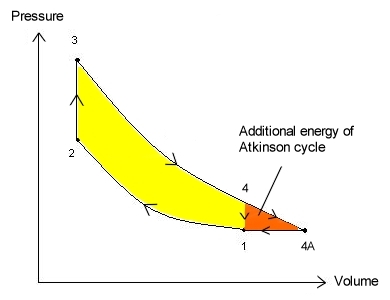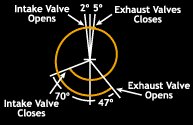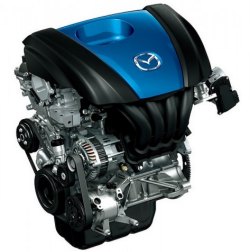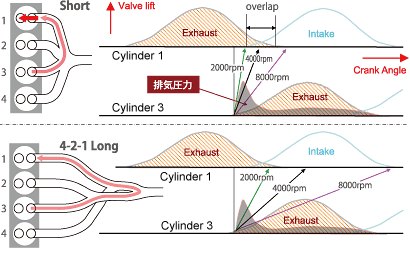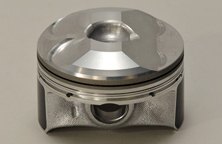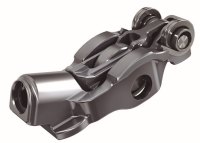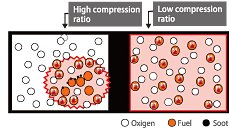|
AUTOZINE TECHNICAL SCHOOL
Compression
Variable Compression - Saab SVC
In 2000, Saab announced a variable compression concept dubbed SVC (Saab Variable Compression). It implemented VC by an innovative and interesting approach - slidable cylinder head and cylinder unit. Let’s see these pictures first:  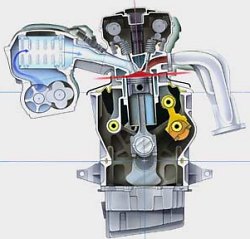 Left: high compression ratio;
Right: low compression ratio
As seen, the SVC engine have a cylinder head with integrated cylinders - which is known as monohead. The monohead is pivoted at the crankcase and its slope can be adjusted slightly (by up to 4 degrees) in relation to the engine block, pistons, crankcase etc. by means of a hydraulic actuator, therefore the volume of the combustion chambers can be varied slightly. When the piston is at top dead center, a small change of volume can lead to big change of compression ratio, ranging from 8:1 to 14:1. 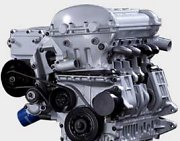 SVC was
cleverer than any previous attempts for variable compression as it
involved no additional moving parts at the
critical combustion chambers or any reciprocating components, so it was
relatively simple, durable and free of leakage. The monohead was
self-contained,
that means it had its own cooling
system, with coolant passages across the head and the cylinder wall.
There was a rubber sealing between the monohead and engine block. SVC was
cleverer than any previous attempts for variable compression as it
involved no additional moving parts at the
critical combustion chambers or any reciprocating components, so it was
relatively simple, durable and free of leakage. The monohead was
self-contained,
that means it had its own cooling
system, with coolant passages across the head and the cylinder wall.
There was a rubber sealing between the monohead and engine block.The VC allowed the Saab engine to run on an unusually high boost pressure, i.e. 1.8 bar (above atmospheric pressure), or about twice the boost pressure of 9-3 Viggen. It was so high that the turbochargers of its days could not provide. Therefore it employed a supercharger instead. The VC was adjustable continuously according to needs - depending on rev, load, temperature, fuel used etc., all determined by the engine management system. Therefore power and fuel consumption (hence emission) could be optimized at any conditions. The SVC demonstrated in 2000 was a 1.6-liter 5-cylinder with 4-valve head. Max output was claimed to be 225 hp and 224 lbft, while fuel consumption was 30% lower than comparable conventional engines. Moreover, the variable compression allowed the engine to drink different Octane fuels easily, so it could be sold worldwide without needing specific tuning. Unfortunately, the SVC never saw the light of production, probably due to its complexity and reliability issue. Variable Compression - Nissan VC-T Unexpectedly, Nissan becomes the first manufacturer to put variable compression ratio engines into production. The so-called VC-T (Variable Compression - Turbo) technology is to be applied to a 2.0-liter four-cylinder turbo and slated to reach the market from early 2018. The first application will be on Infiniti QX50 SUV. 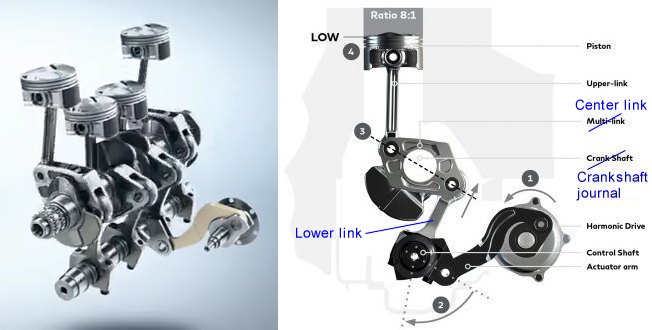 The mechanism Nissan used is very different from Saab's. It varies the length of stroke by using a complicated "multi-link" system in place of conventional connecting rods. As pictured above, the multi-link system consists of an upper link, a diamond-shape center link and a lower link. The diamond-shape center link is mounted on the crankshaft journal, but it is free to swivel about the crankshaft journal. When it swivels clockwise for a few degrees, it will push up the piston thus increase the compression ratio. Vice versa, it will decrease the compression ratio when it swivels anti-clockwise for a few degrees. 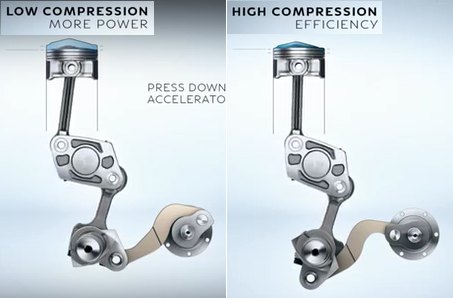 The angle of the diamond-shape center link is controlled by the lower link. An electric motor (called "harmonic drive") rotates the control shaft through an actuator arm. The control shaft connects to the lower link of each cylinder through an eccentric cam. Thanks to the latter, when the control shaft rotates, the lower link can move up or down, adjusting the angle of the diamond-shape center link hence the compression ratio. If you still don't understand, you may watch Nissan's video HERE. 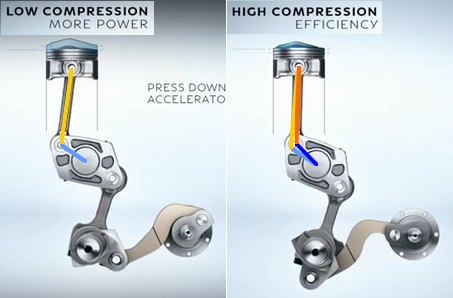 Another benefit of the VC-T technology is that its multi-link geometry keeps the con-rods (upper links) more upright throughout the combustion cycle compared with conventional con-rods. This means less side force is generated, resulting in less vibration and less friction between the pistons and cylinder walls. The former saves the need for balancer shafts, while the latter enhances efficiency further. On the downside, the multi-link system is quite cumbersome, adding considerable weight, inertia and friction. Whether these drawbacks can be offset by the aforementioned benefits is yet to be seen. However, it is certain to be more costly to build, thanks to the additional parts, especially bearings. Moreover, the mechanism is not compatible with V-engines, so its applications will be limited to high-end 4-cylinder engines that can swallow the additional costs. No wonder Nissan wants the 2.0-liter VC-T engine to replace its long-serving 3.5-liter naturally aspirated V6. Rated at 268 hp and 288 lbft of torque, its output is sufficient to do so, while fuel consumption is estimated to be 27% lower than the V6. Nevertheless, compared with some of the best 2-liter turbo engines currently on the market, it has yet to show any advantages. Atkinson Cycle Engine Conventional Otto cycle engines have 4 stages in each combustion cycle – intake, compression, expansion (explosion) and exhaust, each of them takes equal time and piston displacement. Atkinson cycle engines are different. They employ slightly shorter intake stroke than expansion stroke. In other words, the compression ratio is actually smaller than expansion ratio. What is the benefit of this arrangement? The answer is higher fuel efficiency. If we analyse the pressure-volume curve of combustion cycle, you will see:
Atkinson cycle engine is not a new idea. In fact, it was invented by British engineer James Atkinson in 1882. His original design was very complicated, using not only crankshaft but also an auxiliary shaft and additional linkages to allow the pistons travel shorter distance in compression stroke than expansion stroke. It was quite brilliant, but blame to this complexity and resultant extra size and weight, it was never made into commercial use on cars. Application on hybrid cars More recently, car makers resurrected the Atkinson concept in a bid to achieve superior fuel economy. In 1997, Toyota introduced a 1.5-liter Atkinson engine on its first Prius. Since then all of the company's hybrid cars also adopt this kind of engines. They implement Atkinson cycle by delaying the closure of intake valves such that some fresh air is pumped back to the intake manifold in the early phase of compression stroke. This reduces the effective displacement and compression ratio. While the quoted compression ratio (i.e. geometric compression ratio) remains at slightly more than 10:1, the effective compression ratio is closer to 8:1. Except valve timing, modern Atkinson engines are exactly the same as Otto engines, thus adds no extra cost and weight. On the downside, Atkinson-cycle engines are less powerful than their Otto-cycle counterparts of the same size and weight. This is due to several reasons: 1) Smaller effective capacity means less air and fuel involve the combustion thus less power is generated; 2) Lower compression ratio leads to less power; 3) Lower exhaust gas pressure means the exhaust gas escapes slower thus is not benefitial to scavenging effect and revvability. 4) Longer expansion stroke works against high rev. However, the lack of power is less significant on hybrid cars as fuel efficiency is placed at first priority. Also, hybrid cars can compensate the loss of power with electric motors. Otto-Atkinson cycle engines Thanks to stringent requirements for fuel economy, in recent years car makers also started using Atkinson principles on conventional cars. However, they use variable valve timing to adjust the closure timing of intake valves, so that the engines can run Atkinson cycle at idle and light load or switch to Otto cycle when more power is demanded, satisfying the best of both worlds. In 2012, Mazda was the first to put such Otto-Atkinson cycle engines into production. Its innovative 2.0-liter Skyactiv-G employed an unusually high compression ratio of 14.0:1 (or 13:1 for US market due to 87 Octane fuel). As a result, the effective compression ratio at Atkinson mode remained relatively high, minimizing the loss of power. In 2014, Toyota followed the same Otto-Atkinson concept with its 2.0-liter VVT-iW (on Camry), 2.0 Turbo (on Lexus NX200t) and 5.0 V8 (Lexus RC F), although their compression ratios were not as high as Mazda's. The long-abandoned invention of James Atkinson finally takes off, albeit in a much different form. Miller Cycle Engine
Invented by American Ralph Miller in the 1940s, Miller cycle was a variant of Atkinson cycle. As explained above, Atkinson cycle engines use longer expansion stroke than compression stroke to capture the residual energy that would be otherwise lost in exhaust. Therefore it returns higher fuel efficiency than conventional Otto cycle engines. However, a big drawback is lack of power compared with Otto cycle engines of the same size and construction. To address this problem, Miller cycle adds a supercharger to boost the air pressure so to restore 100% effective capacity. Of course, in order to return higher fuel efficiency, the supercharger needs to be efficient, wasting less energy than the saving gained by Miller cycle.
Mazda introduced
a 2.3-liter Miller cycle V6 to its Millenia / Eunos 800
in 1994. It was claimed to consume 13% less fuel than Mazda's 3-liter
conventional V6, while generated more power and a better torque curve.
Nevertheless, since then neither Mazda nor other car makers followed
its footprints. Why? Think about it: although it was claimed to be a
2.3-litre engine, it was actually constructed like a 3-litre engine, no
matter in size, construction and materials. Then the supercharger and
intercoolers added extra cost and weight. Considering the slim
advantage in fuel economy, a smaller super or turbocharged engine could
easily better it. High Compression Engine - Mazda Skyactiv-G
Then why is the combustion chamber so hot ? One of the reasons is the existence of residual exhaust gas, i.e. the exhaust gas that flows back into the combustion chamber during the intake stroke just before the exhaust valves close. No one can completely get rid of residual exhaust gas, because for high breathing efficiency engines always need to run with a certain level of valve overlapping (overlapping between the opening period of intake and exhaust valves). Suppose exhaust gas is 750ºC and the fresh intake air is 25ºC, and their mixture ratio is 1 to 10, you can see the residual exhaust gas can raise the combustion chamber temperature a lot. The more the amount of residual exhaust gas, the higher the combustion chamber temperature is. In other words, if we want to reduce temperature, we can reduce the amount of residual exhaust gas in the combustion chamber.
In the case of Skyactiv-G's 4-2-1 exhaust manifolds (the second picture above), exhaust pressure waves from Cylinder 3 has to travel a long way to reach Cylinder 1, by the time Cylinder 1 has already, or nearly completed its exhaust phase. Therefore the level of residual exhaust gas is much lower than the previous case, especially for low to mid-range rpm. As a result, the Skyactiv-G engine attains lower temperature in its combustion chambers and allows a higher compression ratio to be used. Well, if the principle is so simple, why not others discovered already? It's not that simple, of course. One critical drawback of the long 4-2-1 exhaust manifold is that it takes relatively long time to heat up the NOx catalyst during cold start. In fact, this is exactly the reason why most modern production engines have abandoned this exhaust configuration - with the exception of high-performance engines which may use thin-wall fabricated stainless steel exhaust manifolds to compensate for its extra length. On cost-conscious mass production engines, cheap cast-iron exhaust manifolds are still the norm. Its extra mass and surface area absorb a great deal of heat and delay the proper functioning of catalyst. This causes difficulty to comply with emission regulations.
Low Compression Diesel Engine - Mazda Skyactiv-D 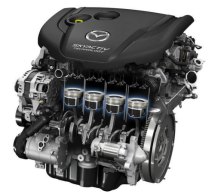 Unlike petrol engines, diesel engines do not
have ignition system as the combustion of diesel-air mixture happens
automatically under the high pressure and temperature attained during
compression stroke. However, this also means diesel engines need to run
higher compression ratios. It goes without saying a higher compression
ratio necessitates stronger cylinder block and head, pistons, con-rods
and bearings to withstand the high pressure. This explains why diesel
engines are much heavier and lower revving than petrol ones. As a
result, reducing compression ratio becomes the trend of diesel engine
development. A decade or so ago, a typical turbo diesel engine ran
about 18:1 compression. Now most employ between 16:1 and 16.5:1, while
some more advanced engines are even down to 15.5:1. However, none of
them are comparable to Mazda's Skyactiv-D engines, which achieve an
incredibly low 14.0:1. Yes, the same as the Skyactiv-G petrol engines. Unlike petrol engines, diesel engines do not
have ignition system as the combustion of diesel-air mixture happens
automatically under the high pressure and temperature attained during
compression stroke. However, this also means diesel engines need to run
higher compression ratios. It goes without saying a higher compression
ratio necessitates stronger cylinder block and head, pistons, con-rods
and bearings to withstand the high pressure. This explains why diesel
engines are much heavier and lower revving than petrol ones. As a
result, reducing compression ratio becomes the trend of diesel engine
development. A decade or so ago, a typical turbo diesel engine ran
about 18:1 compression. Now most employ between 16:1 and 16.5:1, while
some more advanced engines are even down to 15.5:1. However, none of
them are comparable to Mazda's Skyactiv-D engines, which achieve an
incredibly low 14.0:1. Yes, the same as the Skyactiv-G petrol engines. One thing preventing the use of such a low compression ratio is cold start. When the engine is cold, especially at freezing temperature, diesel engines are difficult to start. Traditionally this can be addressed by the use of glow plugs, which heat up part of the combustion chamber where fuel is injected. The lower compression ratio of Skyactiv-D just makes the matter worse as it produces lower temperature in the combustion chambers. It needs quicker acting ceramic glow plugs to deal with cold start. The use of multi-hole piezo fuel injectors, which enables more precise control of fuel spray timing and patterns, is also said to work better at cold starting. Once the engine is started, there is still possibility of misfire. Mazda avoids this by introducing variable valve lift at the exhaust side. During the intake stroke, the VVL opens the exhaust valves slightly, drawing the hot exhaust gas back to the combustion chamber so to increase temperature. Once the desired operating temperature is reached, the VVL can be reverted to normal stage. (Note: now we understand why the high-power versions of Volkswagen EA288 2.0 TDI engine employs variable exhaust cam phasing).
Apart from weight saving, another benefit is emission. In a high-compression diesel engine, fuel is ignited as soon as it is injected into the combustion chamber due to the high pressure and temperature. This gives little time for the fuel to spread throughout the chamber. As the fuel is not sufficiently mixed with air, some fuel has no oxygen to react with, and vice versa. Consequently, the incomplete combustion generates a lot of soot (carbon particles) and NOx. Now with lower compression, the Skyactiv-D allows sufficient time for fuel to mix with air before combustion happens. It is therefore inherently cleaner, saving the need of expensive particle filter and NOx aftertreatment. 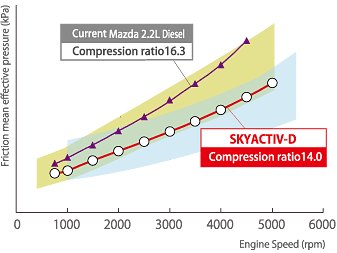 Moreover, under the current stringent
emission standards, high-compression diesel engines may need to retard
the timing of injection to reduce pollutants (this means the injection
takes place after the piston has reached top dead center and started
descending, so both pressure and temperature are reduced). This
effectively shortens the expansion stroke thus waste energy (you can
see it as the opposite of Atkinson-cycle engine).
With lower compression, Skyactiv-D allows the fuel to be injected
before piston reaches TDC, maintaining the expansion stroke thus
capturing more energy. Moreover, under the current stringent
emission standards, high-compression diesel engines may need to retard
the timing of injection to reduce pollutants (this means the injection
takes place after the piston has reached top dead center and started
descending, so both pressure and temperature are reduced). This
effectively shortens the expansion stroke thus waste energy (you can
see it as the opposite of Atkinson-cycle engine).
With lower compression, Skyactiv-D allows the fuel to be injected
before piston reaches TDC, maintaining the expansion stroke thus
capturing more energy. Overall, Mazda said its 2.2-liter twin-turbo Skyactiv-D engine saves 20 percent fuel compared with its same-capacity predecessor with 16.3:1 compression ratio. The lower stress means it can switch from cast-iron block to an aluminum block to save 25 kg. Thinner cylinder head saves another 3 kg. The pistons and crankshaft are 25 percent lighter. Moreover, smaller diameter main journals can be used to reduce friction. The lower friction and lighter reciprocating mass, in addition to the use of 2-stage turbocharging, lift its maximum rev from 4500 rpm to 5200 rpm. As a result, the low-compression diesel engine behaves more like a petrol engine than ever. |
||||||||||||||||||||
| Copyright© 1997-2015 by Mark Wan @ AutoZine |

